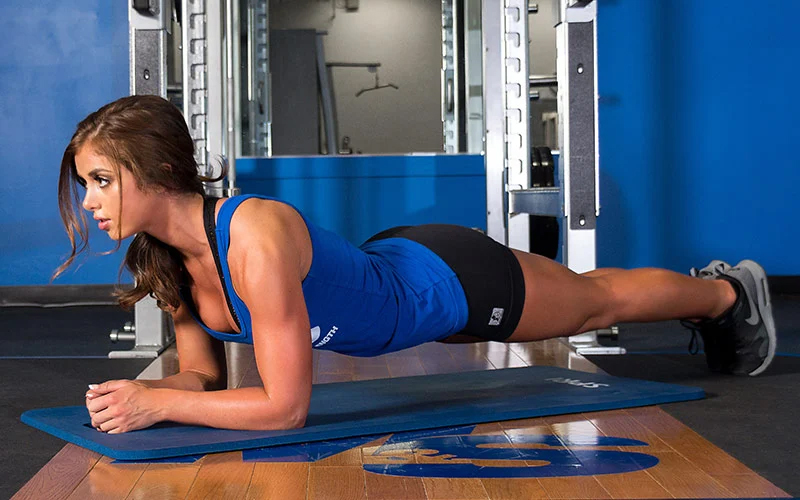The plank exercise is very universal: it helps to make the waist thin, the stomach flat, and the back straight. And in just a few minutes a day!

The Benefits of Forearm Plank
- Strengthens the muscles and ligaments of the spine, therefore, is the prevention of any injuries and diseases associated with it.
- He is working on the waist. It is difficult to make the waist thin by traditional pumping of the press: cubes appear on the stomach, but the volume of the muscles of the press grows, and the waist circumference does not change. The plank allows you to make the waist thinner since statics does not increase muscle mass. For men, the plank helps to get rid of the beer belly, which the usual pumping of the press, as a rule, does not take.
- Improves coordination and balance. Especially varieties of planks with raised arms or legs.
- Saves your time. It is enough to do 10 minutes a day for the result to be noticeable.
Plank Muscles Worked: Do Planks Help Get a Flat Stomach?
90% of the muscles of the body are involved in the plank:
- Quadriceps is the front surface of the thigh. For beginners, they tremble noticeably after 10 seconds in the plank.
- Triceps – the back surface of the hands above the elbow; deltoid muscles – shoulders. They do unusual work because in ordinary life we use them a little.
- The abdominals are the rectus, transverse and oblique muscles of the abdomen. Thanks to static stress, they are strengthened without increasing, and make the stomach flatter!
- The wrist joint (between the hand and the hand itself) if you lean on straight arms, its ligaments and cartilage will significantly strengthen. This will help prevent fractures if you accidentally fall on your hands (for example, when ice is icing or while rollerblading).
- The muscle that straightens the spine. In the plank, she gives an anatomically correct position to the spine, thereby correcting posture.
The plank is a static exercise, that is, you take one position and hold it for a certain amount of time. Advantages of statics: it is safe, works well with small and deep muscles. But to those who love dynamics, it may seem boring. In order not to sour and not discourage you to train, try transitions from one type of plank to another.
Types Of Planks: Planks for Beginners and Experienced Athletes
1. Classic plank
Performed as a stand on the forearms and toes. The palms are clenched into fists, elbows shoulder-width apart and under the shoulders. The forearms are parallel to each other, the back and lower back are on the same line, the stomach is pulled in and tense, the buttocks are also tense, the knees are straightened and connected, resting on the socks. It looks simple, but for beginners, muscles begin to tremble almost immediately.
To make it a little easier, you can put socks wider. To start, hold the plank for 10-15 seconds, try to do it several times a day. Gradually increase the time by 5-10 seconds and bring to 3 minutes without a break. Then you can try other options.
2. Plank on straight arms
It is done almost like a classic, only the support is not on the forearm, but on the palm or fists. In this position, the hands and wrist joint are additionally loaded, the load on the abs and back is increased.
3. The lower plank
Obtained from the previous one: performed on bent hands, stand still on the hands and socks. The load on the triceps (the back surface of the arms), shoulders, and pectoral muscles is increasing.
4. A plank with a raised hand
It is made both from a classic fitness plank, and from the plank on your hands. You simply extend as an extension of the body the arm or leg (or both the arm and leg at the same time). A raised limb increases the load on your partner, abs and back. Raised legs also add stress to the buttocks.
It is recommended to start with 5-10 seconds in this position. Be sure to take turns to raise both hands, or both legs, or both diagonals. If you really want to try, but you don’t have enough strength, stand not on socks, but on your knees, while your knees should be located under the buttocks.
5. Modified side plank
It involves a side stand with support on a straight or bent arm and foot. The second foot is located on the floor in front of the supporting foot or lies on the lower foot, and the second hand on the belt or is lifted vertically upward. It is important to maintain a straight line of the body – legs and retract the stomach. We want to recommend you awesome fitness blog bodypass.net – here you can find all the training plans and exercises you need to get a perfect body! Such a plank intensively works out the abs, back, and hips with buttocks and is especially useful for those who feel a plateau in losing weight.
6. Reverse plank
An analog of the plank on the hands only performed with the back to the floor. You rely on your palms and heels, respectively. It is especially good for correcting stoop, stretching the spine, and getting a flat stomach.
Plank Workout Contraindications
The plank is contraindicated in any inflammatory processes of internal organs (including endometriosis), myoma, cyst, stomach ulcers. And of course, during pregnancy. With caution, you should do the plank with varicose veins and high blood pressure. In this case, it is recommended to alternate it with dynamic exercises (walking, cycling, swimming).
Comments
comments